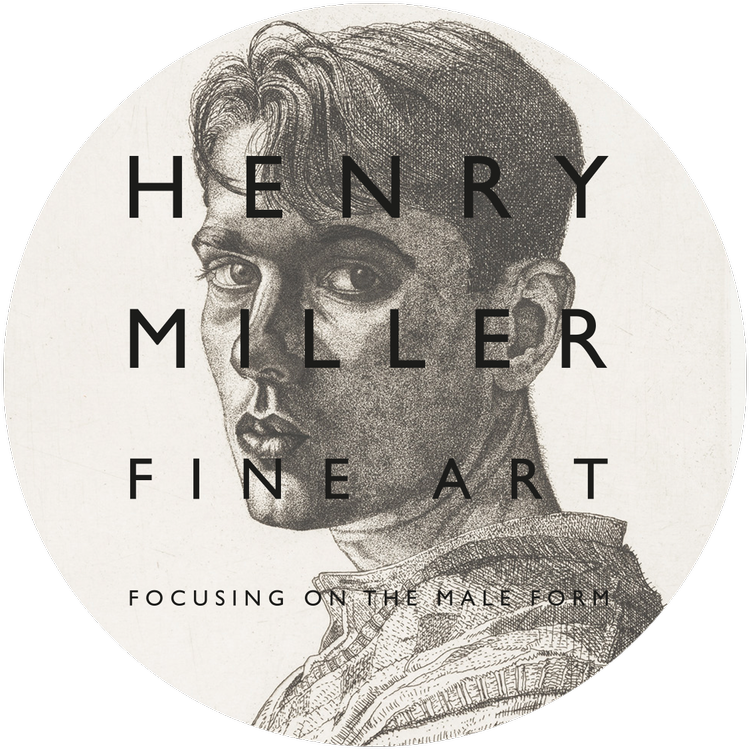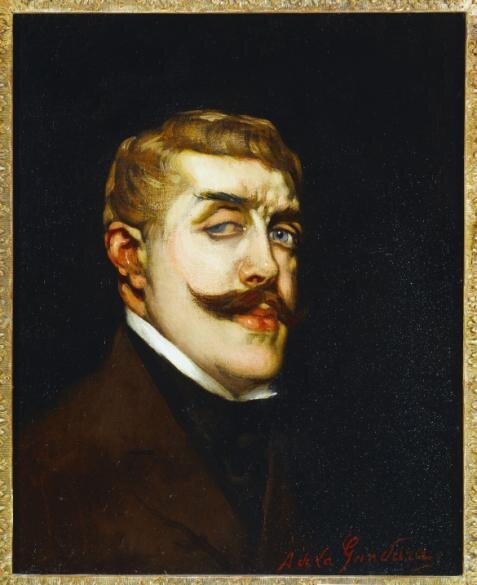With all exhibitions and art fairs in London (and worldwide) now cancelled for the foreseeable future, access to art is understandably limited. As it is not possible for you to come to me, I have decided to come to you and present a series of short pieces highlighting selected pictures from my collection. This is the fourth in the series.
This piece is written by the art historian and author, Patrick Bade. Many of you will have attended Patrick’s wonderful talks at the Coningsby Gallery. Let’s hope we shall all be able attend them again sometime soon!
Antoine Calbet, (French 1860-1944), Conversation, c.1905, Henry Miller Fine Art.
In 1863 the poet Charles Baudelaire published his celebrated and influential essay The Painter of Modern Life that summarized ideas he had developed in his Salon reviews of the 1840s. He appealed to artists to abandon the depiction of historical and mythological themes and instead to look around themselves and to find inspiration in modern Paris. “The life of our city is rich in poetic and marvelous subjects. We are enveloped and steeped as though in an atmosphere of the marvelous; but we do not notice it.” He predicted “The painter, the true painter to come will be he who wrests from the contemporary scene its epic side, and shows how great and poetic we are in our cravats and patent leather boots.”
Manet and Degas took up the challenge and in the years leading up to and following the turn of the century they were followed by such artists as James Tissot, Jean Béraud, Giuseppe de Nittis, Henri de Toulouse-Lautrec, Théophile Steinlen, Ramon Casas, Antoine Calbet and for a short time even by the young Pablo Picasso.
Antoine Calbet (1860-1942) was initially trained in Montpellier and then at the Ecole des Beaux-Arts in Paris where he enrolled in the atelier of Alexandre Cabanel whose notorious Birth of Venus won plaudits and a gold medal in the Salon of 1863 from which Manet’s Déjeuner sur l’Herbe was rejected. Calbet acquired a slick and skillful academic technique to which he added elements borrowed from Degas and the Impressionists. Making his Salon debut in 1880 he enjoyed a highly successful career winning several medals including a silver medal in the Paris World Exhibition of 1900 in which Klimt and Sorolla also won medals. His best known and most easily seen works are the delightful panels depicting the cities of Nice, Evian, Nîmes and Grenoble in the luxurious Train Bleu restaurant at the Gare de Lyons.
Antoine Calbet, Ilustration for La Femme Nue, c.1900, Private Collection
The set piece Salon nudes that won Calbet so much success in his lifetime now look gaudy and vulgar. The simpering smiles and clichéd poses make the pictures seem slightly pornographic. So it comes as a surprise to discover what a subtle observer of modern life he was when worked as an illustrator. He may well have regarded his work as an illustrator of popular novels and Boulevard plays and magazines such as L’Illustration as a pot-boiling sideline but it would seem that this is where his true talent lay. His simple technique of working in charcoal heightened with white chalk and gouache on tinted paper enabled him to achieve extraordinary effects of light and atmosphere and of mood. He seems to have been particularly fascinated by the relatively novel effect of electric lighting. In a striking and highly original illustration to Henry Bataille’s popular play La Femme Nue he depicts a group of people in a dimly lit museum café silhouetted against brightly lit marble statues in the background.
The blatant eroticism of his Salon paintings attest the heterosexuality of the artist and his clientele, but once again his work as an illustrator indicates a far more wide-ranging and nuanced attitude to human sexuality. Amongst the authors with whom Calbet worked were the flamboyantly homosexual Jean Lorrain, pioneer of gay fiction and popularly known as the “ambassador from Sodom” and Pierre Louys whose work evinced a life-long obsession with Lesbianism.
—————————————-
images below: Antoine de La Gandara (1862-1917), Portrait of Jean Lorrain; Felix Vallotton (1865-1925), Portrait of Pierre Louys, 1898.
There can be little doubt about Pierre Louys’ predominant heterosexuality though he was on terms of close friendship with gay authors André Gide and Oscar Wilde and enjoyed what can only be described as an “amitié amoureuse” with the equally straight Claude Debussy. Louys’ photographs of Debussy, particularly one of Debussy asleep in bed, demonstrate the tenderness and intimacy of their relationship. Wilde dedicated his play Salome to Louys. Even to accept such a dedication during the homophobic hullabaloo that surrounded Wilde at the time was an act of considerable courage. Louys was a man of exceptional beauty which was doubtless a factor in his friendship with gay men. Colette left a vivid description of Louys’ semi naked body after she witnesses a passionate quarrel between him and his lover, the actress Polaire, famous for her 16 inch waist and her 38 inch bust. It was, Colette wrote ,“a spectacle unknown to me, love in its youth and brutality, an offended lover, his naked torso, the play of his perfect muscles beneath his softly feminine skin, the bulges and hollows of his proud and indifferent body, the confident manner in which he had knelt, then lifted Polaire from the floor.”
All this provides context for one of Calbet’s most mysterious and intriguing images. It is clearly an illustration of an episode in a novel – perhaps by Jean Lorrain or Pierre Louys.
Antoine Calbet, Untitled Illustration, c.1905, Henry Miller Fine Art.
In what looks like a bourgeois living room we see a smartly dressed young man, cigarette in hand, seated in a comfortable armchair, leaning toward another young man, who stands stripped to his very revealing underwear, with his discarded clothing draped over a chair in the foreground. The fashionable handlebar moustaches of both place the scene firmly in its time. There is no precedent for such a scene in Western art. There is an undoubted erotic tension but the gravity and sobriety of the depiction removes any trace of the salacious or pornographic. We can only speculate at what is going on.
It says much about French attitudes that after a lifetime largely devoted to the exploration of erotic themes, both Calbet and Louys were made officers of the Légion d’Honneur.
Should you have any queries about Calbet’s work, please do not hesitate to get in contact with Henry, either by email or phone.




